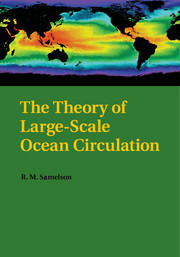Book contents
- Frontmatter
- Contents
- Preface
- 1 Basic Physical Principles and Equations
- 2 Reduced Equations for Large-Scale Motion
- 3 Planetary Geostrophic Vorticity Dynamics
- 4 Stratified Large-Scale Flow
- 5 Circulation in a Simple Rectangular Basin
- 6 Eddy-Driven Subsurface Motion
- 7 Circumpolar Flow
- 8 Mid-Depth Meridional Overturning
- 9 Thermohaline Effects
- 10 Theory and Observation
- Exercises
- References
- Index
1 - Basic Physical Principles and Equations
Published online by Cambridge University Press: 07 October 2011
- Frontmatter
- Contents
- Preface
- 1 Basic Physical Principles and Equations
- 2 Reduced Equations for Large-Scale Motion
- 3 Planetary Geostrophic Vorticity Dynamics
- 4 Stratified Large-Scale Flow
- 5 Circulation in a Simple Rectangular Basin
- 6 Eddy-Driven Subsurface Motion
- 7 Circumpolar Flow
- 8 Mid-Depth Meridional Overturning
- 9 Thermohaline Effects
- 10 Theory and Observation
- Exercises
- References
- Index
Summary
The Large-Scale Ocean Circulation
Systematic observations of the fluid properties of Earth's ocean, made primarily over the course of the last hundred years, reveal coherent features with scales comparable to those of the ocean basins themselves. These include such structures as the subtropical main thermoclines and anticyclonic gyres, which appear in all five midlatitude ocean basins, and the meridional overturning circulations that support the exchange of waters across the full meridional extent of the ocean, from the polar or subpolar latitudes of one hemisphere to the opposing high latitudes of the other. These features and motions, which prove to be connected by robust dynamical balances, constitute the large-scale circulation of the Earth's ocean.
The global field of long-term mean sea-surface temperature is dominated by the meridional gradients between the warm equatorial regions and the cold poles but contains significant zonal gradients as well (Figure 1.1). The global long-term mean sea-surface salinity field has a more complex structure (Figure 1.2), with isolated maxima in the evaporative centers of the midlatitude subtropical gyres. The global sea-surface density field computed from long-term mean temperature and salinity reflects the competing influences of temperature and salinity on density (Figure 1.3). These fields are the surface expressions of complex three-dimensional interior property fields. The downward penetration of the warm equatorial temperatures is generally limited to the upper one-fifth of the water column (Figure 1.4), while salinity perturbations are less strongly confined to shallow depths (Figure 1.5).
- Type
- Chapter
- Information
- The Theory of Large-Scale Ocean Circulation , pp. 1 - 13Publisher: Cambridge University PressPrint publication year: 2011



